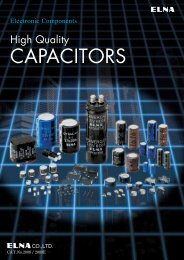Aluminum Electrolytic Capacitors
Aluminum Electrolytic Capacitors
Aluminum Electrolytic Capacitors
Create successful ePaper yourself
Turn your PDF publications into a flip-book with our unique Google optimized e-Paper software.
TECHNICAL NOTEALUMINUM ELECTROLYTIC CAPACITORS®WITH CONDUCTIVE POLYMER SOLID ELECTROLYTECautions for Using <strong>Aluminum</strong> <strong>Electrolytic</strong> <strong>Capacitors</strong> With Conductive Polymer Solid ElectrolytePlease be sure to read this specification before using this product.Before placing an order, please inquire about the Product Specification to check details.Cautions for Usage1. Solid conductive polymer aluminum electrolyticcapacitors are polarized.• Using a capacitor with reversed polarity causesabnormal current flow, resulting in a short circuit.• Cannot use for the circuit to which the polarityreverses by ripple voltage.2. Prohibited Circuits• Since leakage current problem may arise, capacitorscannot be used in the following circuits.Coupling circuitsCircuits greatly affected by leakage current3. Use capacitors within the rated voltage.• The application of voltages exceeding the ratedvoltage can significantly increase leakage current,resulting in a short failure. Please do not apply avoltage exceeding the rated voltage.4. Be careful of excessive rush current.• Using capacitors in the circuit where excessiverush current passes may cause characteristicdeterioration or a short. When the rush currentexceeds 10 A, we recommend use of protectioncircuits to ensure high reliability.5. Use the allowable ripple voltage and the ratedripple current below the specified values.• When superimposing a ripple voltage on a DC biasvoltage, exercise care that the peak voltage valuedoes not exceed the rated voltage and does notreverse the polarity.• The rated ripple current shall be below the specifiedvalue.6. Changes in characteristics due to operatingtemperature• The characteristics of solid conductive polymeraluminum electrolytic capacitors vary by temperatureas follows. These variations are temporaryand recover when the temperature goes back(except for the case of characteristic deteriorationbecause of high temperatures over a long time).Note that using capacitors over the upper categorytemperature increases leakage current, resulting ina short and destruction.Be careful of the capacitor temperature consideringnot only the ambient temperature where theequipment is placed and the temperature inside theequipment but also radiation heat from the heatingelement inside the equipment, and self-heatgeneration by ripple current.Capacitance expressed in the value at 20°C, 120Hz increases with increased temperature anddecreases with decreasing temperature.Tangent of loss angle (tan) expressed in thevalue at 20°C, 120 Hz is temperature-independent.Equivalent series resistance (ESR) expressed inthe value at 20°C, 100 kHz is temperatureindependent.Leakage current increases with increasedtemperature and decreases with decreasingtemperature.7. Changes in characteristics due to frequency• The characteristics of solid conductive polymeraluminum electrolytic capacitors vary by operatingfrequency as follows.Capacitance expressed in the value at 20°C, 120Hz decreases with increased frequency.Tangent of loss angle (tan) expressed in thevalue at 20°C, 120 Hz increases with increasedfrequency.Equivalent series resistance (ESR) expressed inthe value at 20°C, 100 kHz increases withdecreasing frequency.8. Failure modes of solid conductive polymeraluminum electrolytic capacitors• The failure modes of solid conductive polymeraluminum electrolytic capacitors are a wear-outfailure by deterioration of electrical performance anda random failure by a short. The failure rate level is0.5%/1,000h at the reliability level of 60% with thespecified voltage applied at 105°C.• If a short occurs and continues with the applicationof a voltage exceeding the rated voltage, increasingthe internal temperature, the internal pressureincreases by vaporization of the cathode material,which may cause the aluminum case to come off.9. Operating environments• Do not use capacitors in an environment directlyexposed to water, saltwater spray, oil spill orcondensation.• Do not use capacitors in an environment filled withtoxic gas such as hydrogen sulfide, sulfurous acid,nitrous acid, chlorine, ammonia, etc.• Do not use capacitors in a place exposed to ozone,ultraviolet rays, or radiation.10 . Fumigation ProcessCAT.No.2010/2011E






